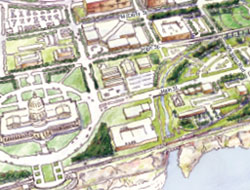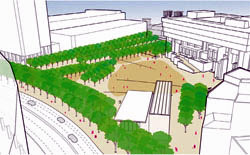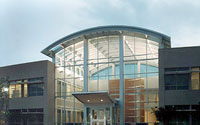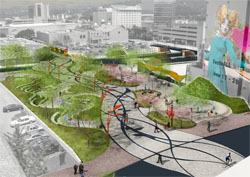Navigation
Green Design and Economic Revitalization Advanced by Greening America’s Capitals Partners
The U.S. Environmental Protection Agency (EPA) today, August 12, 2011, announced that through its Greening America's Capitals (GAC) project, it will help the five capital cities to create healthy communities through green development.
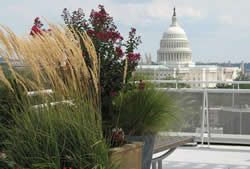 |
| A rooftop in Washington, DC, provides a good view of the U.S. Capitol. Photograph courtesy of U.S. EPA. |
The U.S. Environmental Protection Agency (EPA) today, August 12, 2011, announced that through its Greening America's Capitals (GAC) project, it will help the five capital cities to create healthy communities through green development. GAC helps to stimulate economic development, provide more housing and transportation choices, and reduce infrastructure and energy costs.
The GAC is now in its second year. This year’s selected cities are Alabama, Arizona, Mississippi, Nebraska and the District of Columbia. Last year’s chosen cities were Boston, Massachusetts, Jefferson City, Missouri, Hartford, Connecticut, Charleston, W. Virginia, and Little Rock, Arkansas.
Through this project, EPA provides design assistance from private-sector experts to help these capital cities demonstrate sustainable designs that create vibrant neighborhoods with multiple social, economic, environmental, and public health benefits.
GAC is a project of the Partnership for Sustainable Communities among EPA, the U.S. Department of Housing and Urban Development (HUD), and the U.S. Department of Transportation (DOT). The interagency collaboration coordinates federal investments in infrastructure, facilities, and services to get better results for communities and use taxpayer money more efficiently.
The partnership is helping communities across the country to create more housing choices, make transportation more efficient and reliable, reinforce existing investments, and support vibrant and healthy neighborhoods that attract businesses. HUD and DOT were involved in the review and selection process and will provide technical expertise on each project.
The five city plans chosen for 2011 are: Montgomery, AlabamaThe city of Montgomery is currently working to revitalize and restore the historic Selma to Montgomery National Historic Trail. The city sees an opportunity to use the trail segment that runs beneath the I-65/I-85 interchange to reconnect downtown with Montgomery's west side, specifically, the Renaissance Neighborhood, the first green redevelopment project in the city. The city asked for assistance to create design options for improvements to the Selma to Montgomery National Historic Trail as it passes through the freeway interchange area. The design team will explore how to increase shade, improve lighting, and reduce freeway noise for trail users. The city has also asked for assistance to expand its climate change response planning. Like much of the inland southeast, projected climate changes include higher ambient temperature, decreased annual rainfall, and fewer but more intense storms. The design team will look for opportunities to increase green space to absorb stormwater runoff and help reduce the ambient air temperature. Phoenix, Arizona Lower Grand Avenue is in Phoenix's core and adjacent to downtown and the state capitol. Recent developments along Lower Grand Avenue reveal an emerging, grassroots effort to revitalize the area. In 1998, a federally funded Weed and Seed project, which aimed to reduce violent crime by "weeding" out offenders and "seeding" community services, kick-started a partnership between city, federal, and state agencies, as well as the local faith community, residents, businesses, and nonprofits. This partnership has led to a 40 percent reduction in violent crime over the last 10 years. Artists have colonized the street, taking advantage of inexpensive vacant and underused warehouse and shop spaces. The area is now a focus of an annual art festival and monthly First Fridays art events. The city asked for assistance to improve the Lower Grand Avenue streetscape, making it more environmentally, pedestrian-, and bicycle-friendly while also maintaining the neighborhood's artistic character. The design team will explore options that use green infrastructure techniques suitable for arid climates to capture and treat stormwater runoff. Design options might also include improvements to pedestrian crossings, transit shelters, and bicycle paths.
Washington, D.C.The Anacostia Metrorail station is on the east side of the Anacostia River, an area that Mayor Vincent Gray's administration has prioritized for improvements. The city expects this area to see significant increases in population and visitors due to development at the St. Elizabeth's West Campus (future home of the Department of Homeland Security), two mixed-income developments, and a proposed riverfront development at Poplar Point. This transit node will become an important asset in the community and the city. The city wants to improve the plaza at the Metrorail station and three intersections surrounding the station. Currently, the area lacks a distinctive character and, although it is next to the Anacostia River, it lacks pedestrian access to the river. The intersections surrounding the station are some of the city's most dangerous for pedestrians. The city is seeking design assistance with improving connections between the Metrorail station and nearby neighborhoods and schools, the Anacostia business district, and the Anacostia River. The design team's areas of focus will be safety concerns at the intersections, improved signage, increasing the overall permeability of the area to manage stormwater, and creating a strong community identity.
Jackson, MississippiThe Green Government Center is a Jackson initiative that is exploring retrofitting public spaces within about a half-mile radius of the state capitol building with green technologies. These green technologies include solar-powered water fountains, indigenous and drought-tolerant landscaping, rain gardens for stormwater treatment, and permeable paving systems. The area includes the Farish Street Historic District, the city's oldest African-American community. Several major streets run through the area, including Congress Street, along which sits the state capitol, the city hall, the governor's mansion, and other sites of historical significance. The city requested assistance from the Greening America's Capitals design team to develop design concepts that use green technologies and green infrastructure for Congress Street and two public parks along the street. The city wants Congress Street to be more bike- and pedestrian-friendly to better connect the civic buildings with adjacent neighborhoods and businesses. Another goal is for Congress Street to have a significant increase in street trees to provide more shade for pedestrians. The city hopes the design options for Congress Street can set an example of green development that can be used across the state. Lincoln, NebraskaThe city of Lincoln is planning to revitalize the South Capitol neighborhood, a primarily residential neighborhood directly south of the capitol, through improvements to the neighborhood's streets and alleys. The neighborhood currently has deteriorating housing and businesses, wide streets, no bicycle lanes, aging sanitary sewer and water mains, and lower per capita income than the rest of the city. The city will incorporate the Greening America's Capitals project into Mayor Chris Beutler's Stronger, Safer Neighborhood Initiative, which creates public-private partnerships to improve the quality of life in the neighborhood through ongoing community-building activities such as installing public art and sponsoring neighborhood-based, community-wide events. The Greening America's Capitals team will involve local residents in developing design options for the neighborhood's streets that improve pedestrian and bicyclist safety and comfort, add more street trees, and incorporate green infrastructure elements such as rain gardens to manage and treat stormwater runoff and make the streets more attractive. The city could consider the design options for the South Capitol neighborhood as a model to improve the quality of life for other neighborhoods in Lincoln facing similar issues.
The five capital cities were selected from 23 letters of interest received through a solicitation of interest by EPA. The agency will organize teams of regional urban designers, planners, and landscape architects to provide customized technical assistance as requested by each community. In addition to helping the selected state capitals build a greener future and civic pride, the assistance will help create models that many other cities can look to in creating their own environmentally and economically sustainable designs for growth and development.
Summaries from the five cities chosen in 2010 are available at:
| ||||||||||
| Check out EPA's new Green Building Blog | ||||||||||
Search
Latest articles
Agriculture
- World Water Week: Healthy ecosystems essential to human health: from coronavirus to malnutrition Online session Wednesday 24 August 17:00-18:20
- World Water Week: Healthy ecosystems essential to human health: from coronavirus to malnutrition Online session Wednesday 24 August 17:00-18:20
Air Pollution
- "Water and Sanitation-Related Diseases and the Changing Environment: Challenges, Interventions, and Preventive Measures" Volume 2 Is Now Available
- Global Innovation Exchange Co-Created by Horizon International, USAID, Bill and Melinda Gates Foundation and Others
Biodiversity
- World Water Week: Healthy ecosystems essential to human health: from coronavirus to malnutrition Online session Wednesday 24 August 17:00-18:20
- Mangrove Action Project Collaborates to Restore and Preserve Mangrove Ecosystems
Desertification
- World Water Week: Healthy ecosystems essential to human health: from coronavirus to malnutrition Online session Wednesday 24 August 17:00-18:20
- UN Food Systems Summit Receives Over 1,200 Ideas to Help Meet Sustainable Development Goals
Endangered Species
- Mangrove Action Project Collaborates to Restore and Preserve Mangrove Ecosystems
- Coral Research in Palau offers a “Glimmer of Hope”
Energy
- Global Innovation Exchange Co-Created by Horizon International, USAID, Bill and Melinda Gates Foundation and Others
- Wildlife Preservation in Southeast Nova Scotia
Exhibits
- Global Innovation Exchange Co-Created by Horizon International, USAID, Bill and Melinda Gates Foundation and Others
- Coral Reefs
Forests
- NASA Satellites Reveal Major Shifts in Global Freshwater Updated June 2020
- Global Innovation Exchange Co-Created by Horizon International, USAID, Bill and Melinda Gates Foundation and Others
Global Climate Change
- World Water Week: Healthy ecosystems essential to human health: from coronavirus to malnutrition Online session Wednesday 24 August 17:00-18:20
- Mangrove Action Project Collaborates to Restore and Preserve Mangrove Ecosystems
Global Health
- World Water Week: Healthy ecosystems essential to human health: from coronavirus to malnutrition Online session Wednesday 24 August 17:00-18:20
- More than 400 schoolgirls, family and teachers rescued from Afghanistan by small coalition
Industry
- "Water and Sanitation-Related Diseases and the Changing Environment: Challenges, Interventions, and Preventive Measures" Volume 2 Is Now Available
- Global Innovation Exchange Co-Created by Horizon International, USAID, Bill and Melinda Gates Foundation and Others
Natural Disaster Relief
- STOP ATTACKS ON HEALTH CARE IN UKRAINE
- Global Innovation Exchange Co-Created by Horizon International, USAID, Bill and Melinda Gates Foundation and Others
News and Special Reports
- World Water Week: Healthy ecosystems essential to human health: from coronavirus to malnutrition Online session Wednesday 24 August 17:00-18:20
- STOP ATTACKS ON HEALTH CARE IN UKRAINE
Oceans, Coral Reefs
- World Water Week: Healthy ecosystems essential to human health: from coronavirus to malnutrition Online session Wednesday 24 August 17:00-18:20
- Mangrove Action Project Collaborates to Restore and Preserve Mangrove Ecosystems
Pollution
- Zakaria Ouedraogo of Burkina Faso Produces Film “Nzoue Fiyen: Water Not Drinkable”
- "Water and Sanitation-Related Diseases and the Changing Environment: Challenges, Interventions, and Preventive Measures" Volume 2 Is Now Available
Population
- "Water and Sanitation-Related Diseases and the Changing Environment: Challenges, Interventions, and Preventive Measures" Volume 2 Is Now Available
- "Water and Sanitation-Related Diseases and the Changing Environment: Challenges, Interventions, and Preventive Measures" Volume 2 Is Now Available
Public Health
- Honouring the visionary behind India’s sanitation revolution
- Honouring the visionary behind India’s sanitation revolution
Rivers
- World Water Week: Healthy ecosystems essential to human health: from coronavirus to malnutrition Online session Wednesday 24 August 17:00-18:20
- Mangrove Action Project Collaborates to Restore and Preserve Mangrove Ecosystems
Sanitation
- Honouring the visionary behind India’s sanitation revolution
- Honouring the visionary behind India’s sanitation revolution
Toxic Chemicals
- "Water and Sanitation-Related Diseases and the Changing Environment: Challenges, Interventions, and Preventive Measures" Volume 2 Is Now Available
- Actions to Prevent Polluted Drinking Water in the United States
Transportation
- "Water and Sanitation-Related Diseases and the Changing Environment: Challenges, Interventions, and Preventive Measures" Volume 2 Is Now Available
- Urbanization Provides Opportunities for Transition to a Green Economy, Says New Report
Waste Management
- Honouring the visionary behind India’s sanitation revolution
- Honouring the visionary behind India’s sanitation revolution
Water
- Honouring the visionary behind India’s sanitation revolution
- Honouring the visionary behind India’s sanitation revolution
Water and Sanitation
- Honouring the visionary behind India’s sanitation revolution
- Honouring the visionary behind India’s sanitation revolution

